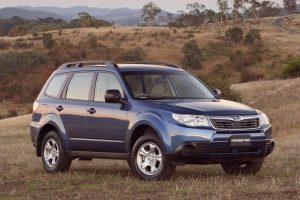Recalls: Subaru SH Forester
Overview
Manufacturers, or importers, issue recalls for defects or faults which have the potential to cause injury. Generally, manufacturers will inform the original buyers if their vehicle is subject to a recall and of the steps required to remedy the defect or fault. Please note that the recalls below (if any) are for Australian-delivered vehicles only. Furthermore, the number of recalls should not be taken as an indication of a model’s reliability or its safety more generally.
Recalls: Subaru SH Forester
2009 ‘model year’ Subaru SH Forester: deformed turbocharger oil supply pipe
In November 2008, a recall was issued for certain 2009 model year Subaru SH Forester turbocharged vehicles. In the recalled vehicles, the turbocharger oil supply pipe may have been deformed due to misalignment during the assembly process. If the pipe was deformed, vibration experienced during normal driving could result in a crack developing over time and causing an engine oil leak (PRA 2008/10430).
2009 ‘model year’ Subaru SH Forester: inadequate welding of tow bar
In April 2009, a recall was issued for 2009 model year Subaru Forester vehicles, fitted with a genuine accessory Subaru tow-bar and sold until 28 February 2009 from chassis number 002004 to 023052. For these vehicles, some tow-bars may have been manufactured with inadequate welding on the tow-ball mount (commonly known as the towing tongue or goose-neck) and/or incorrect specification bolts that anchor the tow-bar arms to the chassis rails (PRA 2009/10721).
2010 ‘manufacture year’ Subaru SH Forester: transmission omitted lubrication supply passage
In July 2010, a recall was issued for 2010 manufacture year Subaru Forester vehicles fitted with a six-speed manual transmission and in the VIN range JF2SHHKZ3AG 04174 to 050927. For some of these vehicles, the transmission was manufactured without a lubrication supply passage. Beyond 10,000 km, the insufficient supply of lubricant to the transmission may cause fretting of the third and fourth gear components and eventual failure of those driven gears (PRA 2010/11814).
2009-12 ‘model year’ Subaru Forester XT: faulty secondary air pump relay
In October 2016, a recall was issued for 2009 to 2012 ‘model year’ Subaru Forester XT vehicles because the secondary air pump relay may be faulty. If the relay was faulty, the secondary air pump could be powered continuously and overheat, posing a fire risk (PRA 2016/15674).
2009-12 model year Subaru SH Forester: front passenger airbag hazard
In November 2016, a recall was issued for 2009 model year Subaru Forester vehicles; this recall, however, was subsequently extended to include 2009 to 2012 model year Subaru Forester vehicles. In these vehicles, the inflator for the front passenger airbag contained propellant wafers that could absorb moisture over time. As a result, the airbag may inflate in an overly aggressive manner that could cause the airbag inflator housing to rupture. If this occurred, metal fragments could be dispersed throughout the cabin, posing a hazard to occupants. For the VINs of the recalled Subaru Forester, please see PRA 2016/15766.
Subaru SH Forester: recall of like-for-like replacement Takata airbags
In April 2019, recall campaign SRT-271 was issued for Subaru SH Forester vehicles that had previously been recalled for ‘like-for-like’ replacement of their Takata airbags. As such, recall campaign SRT-271 was issued so that the replacement Takata airbags – which had the same defect whereby propellant wafers could absorb moisture over time – could be replaced with defect-free airbags. For the VINs of the recalled vehicles, please see PRA 2019/17508.
Subaru SH Forester: defective replacement ignition switch
In June 2019, recall campaign SRT 272 was issued for Subaru SH Forester vehicles because a replacement ignition switch may have had imperfections in its ball springs. Over time, these imperfections could cause the ignition switch to fail and the key may inadvertently move from the ‘ON’ position to the ‘ACC’ position while the vehicle was moving. If this occurred, the engine would stop running (causing the vehicle to unexpectedly slow down and stop) and the power supply to the SRS airbag would be cut (so that the airbag would not deploy in the event of a collision). As such, the vehicle would pose a hazard to occupants and other road users. For the VINs of the recalled vehicles, please see PRA 2019/17514.
Search online for recalls by VIN
To see if a Subaru vehicle has been recalled, you can conduct a search on the Subaru Australia website using its VIN.
Problems and faults: Subaru SH Forester
Overview
This section identifies potential problems, causes and fixes based on the experiences of owners and repairers, online sources and technical service bulletins. This information is provided solely for reference purposes and AustralianCar.Reviews recommends that only properly qualified persons carry out repairs or modifications. Furthermore, the number of items below should not be taken as an indicator of a model’s reliability or the frequency with which they may occur.
To report a problem or fault to the AustralianCar.Reviews team, please use the Contact Us form. Note that AustralianCar.Reviews does not offer advice on automotive problems or disputes; such enquiries will not receive a reply. For vehicles purchased from dealers after 1 January 2011, please see our Australian Consumer Law fact sheet.
Subaru SH Forester 2.5i: EJ25 head gasket failure
In rare cases, the 2.5-litre EJ253 F4 engine may experience head gasket failure due to external oil leaks or warped cylinder heads.
- Symptoms: early signs of head gasket failure include an oily residue in the coolant overflow bottle, or an exhaust/fuel/sulfur smell in the coolant overflow bottle. Beyond this, the coolant temperature gauge may intermittently show higher-than-normal readings, followed by intermittent overheating (particularly during long highway drives). In the case of external leaks, these can be spotted by a visual inspection of the bottom side of the engine with the splash pan removed.
- Prevention: to minimise the risk of head gasket failure, 1) oil and coolant should be changed regularly and in accordance with how the car is used. As such, the scheduled time/kilometre intervals may be inadequate in some cases; and, 2) any corrosion around battery cables should be removed. Corroded battery cables increased ground circuit resistance, thereby increasing the voltage in the cooling system and causing electrolysis; the coolant could also damage the metal head gasket and seals.
2010-12 Subaru SH.II Forester 2.5L: rough idle, extended cranking times or won’t start
In June 2013, Subaru issued Service Bulletin 11-130-13R for 2010-12 Subaru SH.II Forester vehicles with 2.5-litre FB25 engines. For these vehicles, the driver may notice illumination of the ‘check engine’ light, a rough or uneven idle, extended cranking times or an inability to start the vehicle. Furthermore, the powertrain control module (PCM) may log diagnostic trouble codes (DTCs) related to the position of the intake or exhaust camshafts and/or engine misfires – these included P0340, P0341, P0345, P0346, P0365, P0366, P0390, P0391, P0301, P0302, P0303 and P0304.
According to the bulletin, these diagnostic trouble codes may be attributable to camshaft position sensor (CPS) clearance being out of specification. To fix, Subaru issued two camshaft position sensor shim kits and a camshaft position sensor O-ring that were to be used to correct camshaft position sensor clearance.
Subaru SH Forester: other problems and faults
- For early models, the protective film on the rear doors did not extend far enough, making the paint susceptible to stone chips.
- A rubbing noise from the front end of the vehicle – usually more pronounced in cold weather – may require improved stabiliser bushings to be installed.
- Water may leak into the front footwells due to a bad seal on the body seam near the front fenders or due to a leak in the cowl area.




